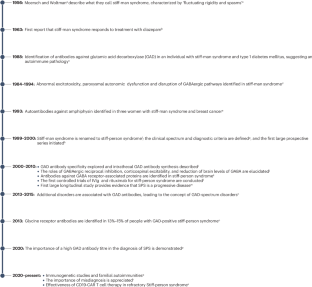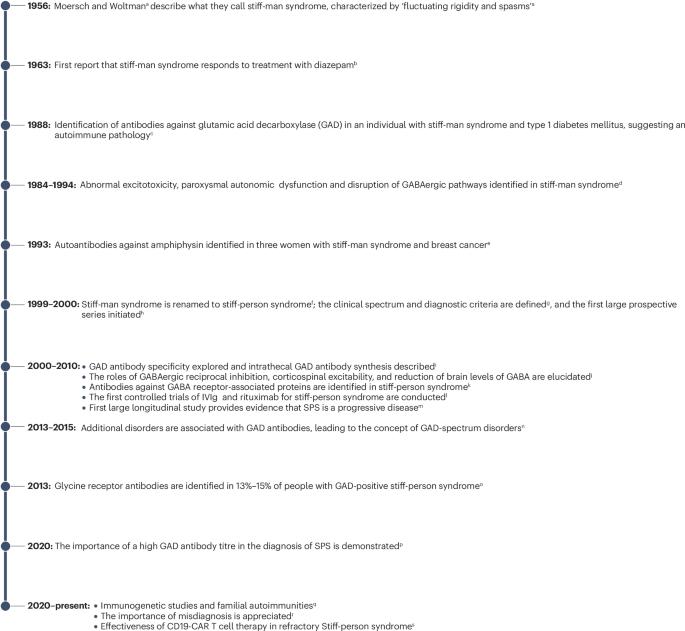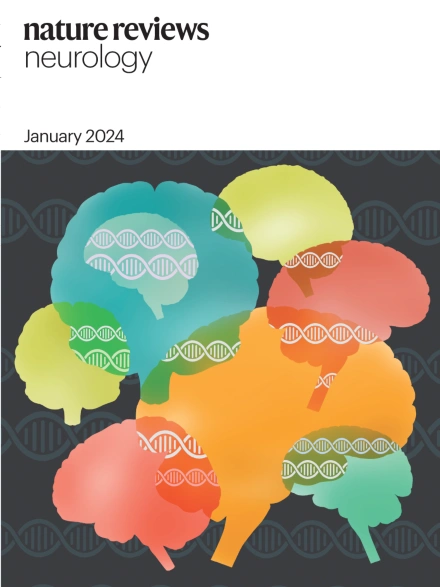僵人综合征及相关疾病--诊断、机制和疗法
IF 28.2
1区 医学
Q1 CLINICAL NEUROLOGY
引用次数: 0
摘要
僵人综合征(SPS)是最典型、最常见的自身免疫性神经元过度兴奋症。它表现为四肢和轴向肌肉僵硬、步态僵硬和无法控制的跌倒,以及由焦虑、特定任务恐惧症和惊吓反应引发的阵发性疼痛性肌肉痉挛,共同导致残疾。患者和医生对 SPS 的认识不断提高,这引起了他们对诊断、误诊和治疗的关注。本综述探讨了SPS和重叠的谷氨酸脱羧酶(GAD)抗体谱系障碍在诊断方面不断变化的挑战,强调了越来越多的过度诊断,并重点介绍了我们在了解SPS病理生理学、GAD抗体和其他抑制性突触抗原以及神经元过度兴奋性的基本原理方面所取得的进展。本研究探讨了 GABA 能或甘氨酸能抑制在大脑皮层和神经系统多个层面的作用;潜在的自身免疫和 GAD 抗体的参与;抗体之外的免疫致病机制,包括环境诱因;家族性和免疫遗传易感性;以及潜在的 T 细胞细胞毒性。最后,介绍了靶向治疗干预的机制原理以及现有的治疗方法,包括 GABA 信号增强剂药物和免疫疗法。本文章由计算机程序翻译,如有差异,请以英文原文为准。


Stiff-person syndrome and related disorders — diagnosis, mechanisms and therapies
Stiff-person syndrome (SPS) is the prototypical and most common autoimmune neuronal hyperexcitability disorder. It presents with stiffness in the limbs and axial muscles, stiff gait with uncontrolled falls, and episodic painful muscle spasms triggered by anxiety, task-specific phobias and startle responses, collectively leading to disability. Increased awareness of SPS among patients and physicians has created concerns about diagnosis, misdiagnosis and treatment. This Review addresses the evolving diagnostic challenges in SPS and overlapping glutamic acid decarboxylase (GAD) antibody spectrum disorders, highlighting the growing number of overdiagnoses and focusing on the progress made in our understanding of SPS pathophysiology, antibodies against GAD and other inhibitory synaptic antigens, and the fundamentals of neuronal hyperexcitability. It considers the role of impaired GABAergic or glycinergic inhibition in the cortex and at multiple levels in the neuraxis; the underlying autoimmunity and involvement of GAD antibodies; immunopathogenic mechanisms beyond antibodies, including environmental triggers; familial and immunogenetic susceptibility; and potential T cell cytotoxicity. Finally, the mechanistic rationale for target-specific therapeutic interventions is presented along with the available therapeutic approaches, including enhancers of GABA signalling drugs and immunotherapies. Stiff-person syndrome is an autoimmune neuronal hyperexcitability disorder that causes limb stiffness, painful spasms and falls, and increased awareness of the disease is creating diagnostic and management challenges. In this Review, Dalakas provides an overview of the current clinical and mechanistic understanding of stiff-person syndrome and related disorders and discusses current and emerging therapeutic interventions.
求助全文
通过发布文献求助,成功后即可免费获取论文全文。
去求助
来源期刊

Nature Reviews Neurology
医学-临床神经学
CiteScore
29.90
自引率
0.80%
发文量
138
审稿时长
6-12 weeks
期刊介绍:
Nature Reviews Neurology aims to be the premier source of reviews and commentaries for the scientific and clinical communities we serve. We want to provide an unparalleled service to authors, referees, and readers, and we work hard to maximize the usefulness and impact of each article. The journal publishes Research Highlights, Comments, News & Views, Reviews, Consensus Statements, and Perspectives relevant to researchers and clinicians working in the field of neurology. Our broad scope ensures that the work we publish reaches the widest possible audience. Our articles are authoritative, accessible, and enhanced with clearly understandable figures, tables, and other display items. This page gives more detail about the aims and scope of the journal.
 求助内容:
求助内容: 应助结果提醒方式:
应助结果提醒方式:


